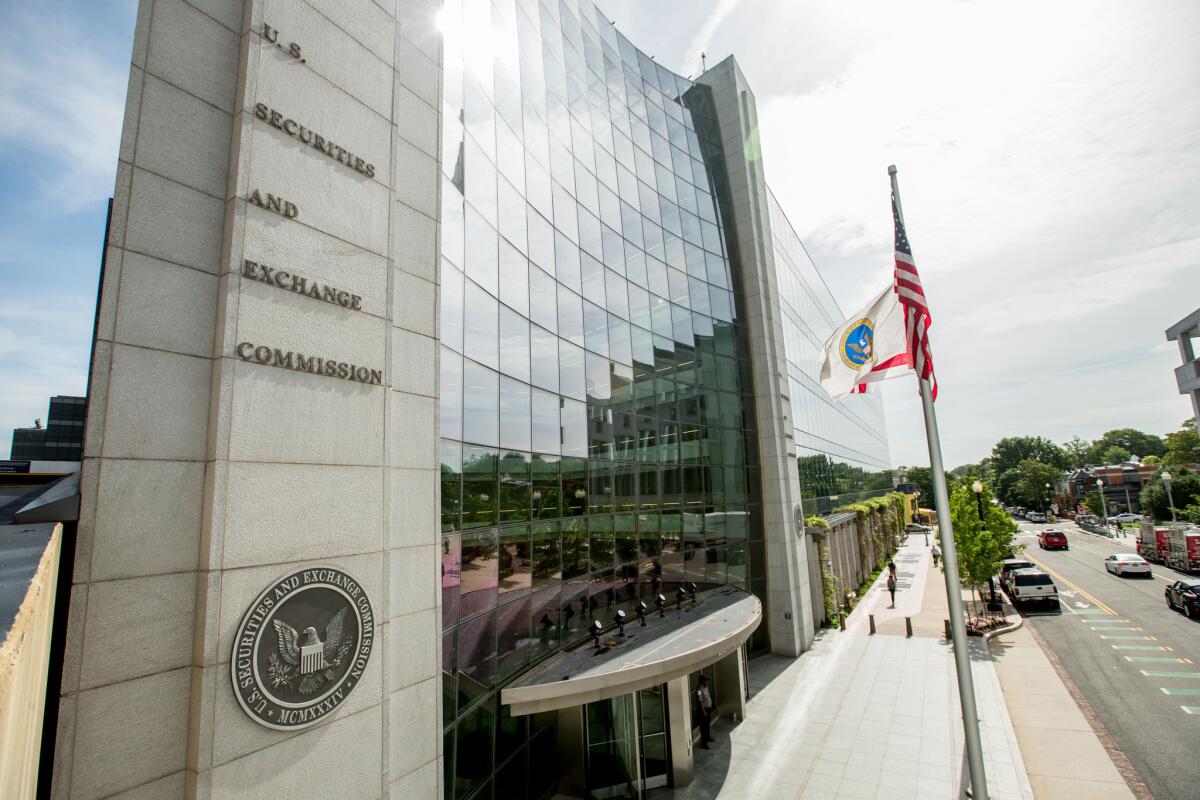CEO pay-ratio rule likely to heat up debate on income inequality

The Securities and Exchange Commission adopted a rule compelling public companies to report the ratio between their chief executive’s annual compensation and the median, or midpoint, pay of employees.
- Share via
The pay gap between workers and the boss is about to get a bit more obvious.
The Securities and Exchange Commission voted Wednesday to require public companies to disclose the pay difference between the chief executive and the average worker — a controversial measure that is sure to stoke an already heated debate about income inequality in the broader economy.
The commission voted 3 to 2 along partisan lines, with Democratic appointees arguing that the measure will help shareholders hold corporate boards accountable in setting executive pay and Republican members saying the proposal is burdensome and a misuse of securities laws.
The new rule, required under the 2010 Dodd-Frank financial reform law, would require the nation’s 4,000 publicly traded companies to disclose the ratio of the CEO’s annual total compensation to the median annual total compensation of the company’s employees.
Under the rule, public companies would divulge this pay ratio for the first time, alongside the actual pay of the CEO and four other top positions, which have long been disclosed. The rule applies to reporting for financial statements for 2017 and beyond, meaning the first disclosures will appear in spring 2018.
The rule is part of a series of SEC regulations to expand executive compensation disclosure and shareholder rights under Dodd-Frank, including a 2011 rule that requires corporations to give shareholders a right to approve executive compensation packages, the “Say on Pay” measure.
The pay-ratio proposal has triggered a highly charged debate among business and public interest groups and others who inundated the SEC with more than 280,000 comments and more than 1,500 letters, SEC Chairwoman Mary Jo White said in introducing the proposal.
“To say that this proposal has been hotly debated would be an understatement,” said White, who voted for the measure.
Opponents blasted the proposal’s cost — $1.3 billion in the first year and $526 million annually, according to testimony Wednesday — and complexity, particularly for firms with global operations and a high percentage of seasonal or part-time workers.
“It’s cost without a purpose,” said John Engler, president of the Business Roundtable, a Washington association of CEOs of major, mostly public, companies.
Although the rule is intended to give company shareholders more information when considering CEO compensation, the initiative comes amid wider concerns about growing wealth and income gaps between top earners and the middle class.
A recent study by the Economic Policy Institute, a labor-affiliated think tank, found that CEOs of large public companies on average earn more than 10 times what they did 30 years ago, far outstripping the pay rise of even highly skilled workers during the period.
The study said average CEO compensation was $16.3 million in 2014, an increase of 997% since 1978, compared with 10.9% growth for the typical worker. The compensation ratio was 303 to 1 in 2014, up from 20 to 1 in 1965, the study said.
The new pay-gap disclosure is likely to include some eye-catching figures.
According to analysis of 2013 data from PayScale, an online compensation information company, the cash compensation of CVS Health Corp.’s Larry J. Merlo represented the largest CEO-worker pay gap with a ratio of 422 to 1. Goodyear Tire and Rubber Co.’s Richard J. Kramer came in second with a ratio of 323 to 1, and Walt Disney Co.’s Robert Iger rounded out the top three with a ratio of 283 to 1.
A spokesman for CVS said: “Consistent with our pay-for-performance philosophy, annual compensation for our CEO and other executives is in line with industry standards and closely reflects the company’s financial performance and success, taking into account the company’s achievement of short-term strategic, operational and financial goals as well as progress toward our long-term objectives.”
Representatives of Goodyear and Disney didn’t reply to requests for comment.
Some companies disclosed their CEO pay ratio ahead of Wednesday’s SEC vote. Noble Energy Inc. said in its March proxy statement that the annual total direct compensation for Charles Davidson, immediate past CEO, was 82 times that of the median annual total direct compensation for all of its employees. Davidson had annual total direct compensation of $8.5 million in 2014.
Recent academic literature suggests that the executive compensation issue is more than symbolic.
A 2012 paper by Williams College economist Jon Bakija and two co-authors used tax data to zero in on which professions have gained most in recent decades and found that corporate executives, managers and supervisors accounted for 45% of the top 0.1% of national earners, and that those from public companies made up a significant percentage. If financial professionals are included, the group accounted for 70% of the increase in the share of national income going to the top 0.1% from 1979-2005, the study said.
Bakija said the fact that executive-income gains were far larger in the U.S. — and, to a lesser extent, other English-speaking countries — than other advanced economies suggests that the increases were, to at least some degree, linked to U.S. compensation practices and other cultural factors, not strictly economics, and that initiatives like the SEC’s could have an impact.
“Given how big the difference is across countries, it seems plausible that cultural attitudes might make a difference,” Bakija said.
Proponents hope the bill will spur shareholders to force corporate boards to curb executive pay and disperse corporate revenues more broadly.
Larry Mishel, president of the Economic Policy Institute in Washington, said the proposal should help highlight what he called both the sharply increasing pay levels for executives, disparities with the rank-and-file and a growing disconnect between executive pay and performance. Further, he said, the rule’s influence should affect the wider economy by forcing pay levels down.
“I used to think this was symbolic,” he said. “But the fact is, the pay of people in publicly held companies drives the executive pay market — for people in privately held firms, for universities, for hospitals.”
Others said the measure addresses a problem that doesn’t exist.
Steven N. Kaplan, a University of Chicago professor of finance and economics, said the new rule is “largely irrelevant” and “purely political.” He said the rule, although required by Dodd-Frank, is far removed from the law’s purpose of preventing future financial
crises.
He said many assumptions underlying the rule are false and that CEO pay, after sharp increases in the 1980s and 1990s, has been largely flat since 2000.
He said most executive compensation is tied to the company’s stock price, meaning CEO pay is tied to performance. Kaplan added that since “Say on Pay” was adopted, for instance, shareholders have approved corporate pay packages in the overwhelming number of cases.
“The view that the system is broken is completely wrong,” he said.
dean.starkman@latimes.com
samantha.masunaga@latimes.com
ALSO:
Tesla’s push for tougher emission standards would boost its bottom line
Yelp adds healthcare data for hospitals, nursing homes to reviews
Gates, Ellison, Bezos top Forbes’ World’s Richest in Tech list
More to Read
Inside the business of entertainment
The Wide Shot brings you news, analysis and insights on everything from streaming wars to production — and what it all means for the future.
You may occasionally receive promotional content from the Los Angeles Times.












